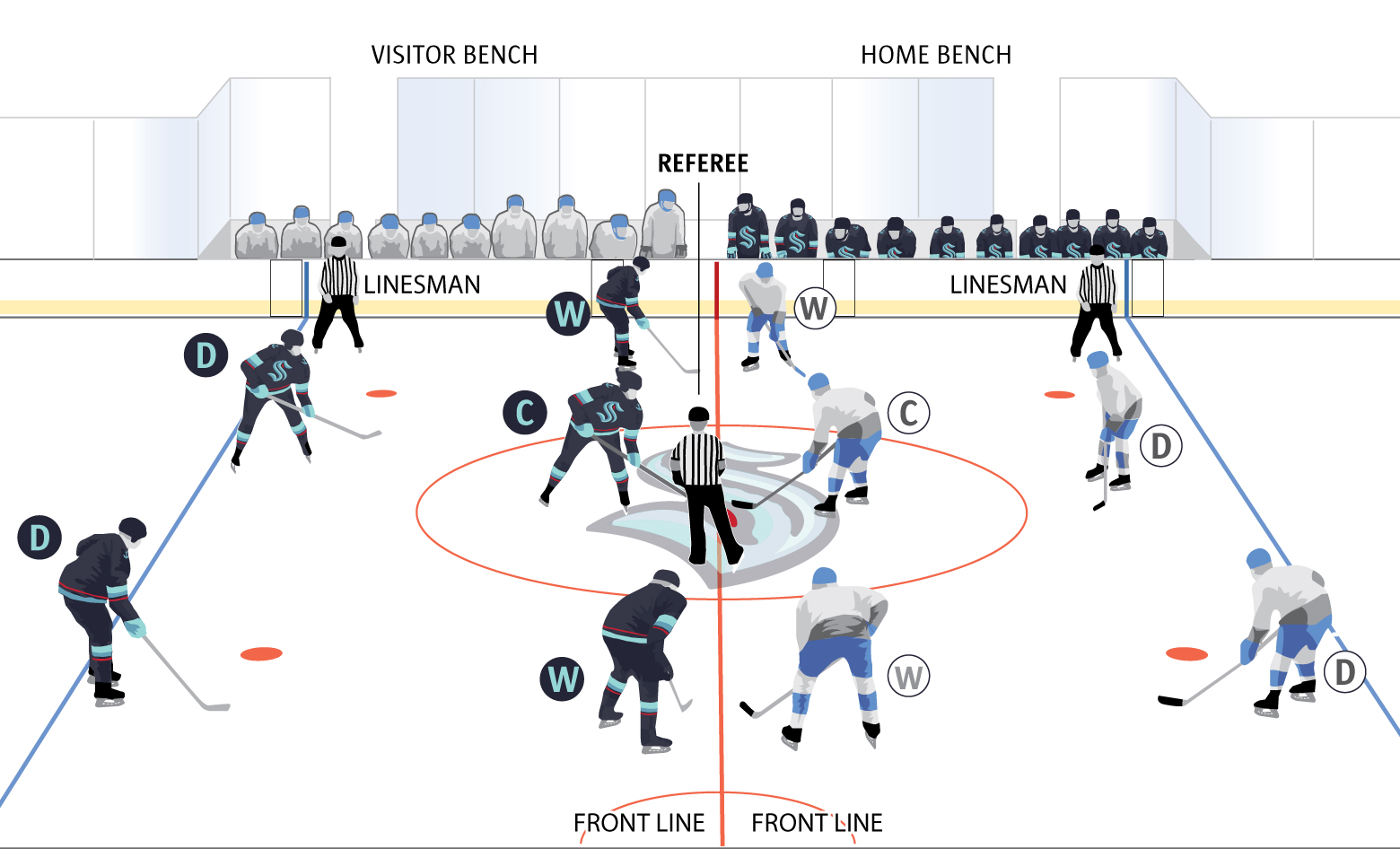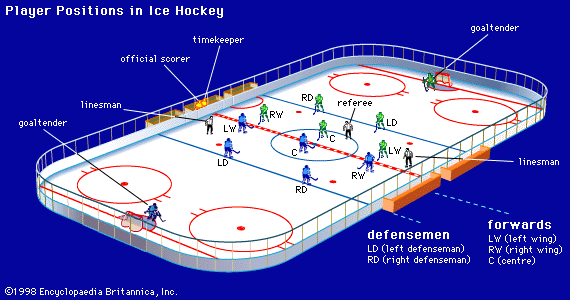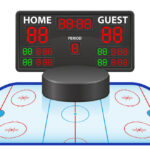A hockey team has six players on the ice: one goalie and five skaters. Skaters include three forwards and two defensemen.
Hockey is an exhilarating and fast-paced sport. Each team has six players on the ice during play. The lineup consists of one goaltender, three forwards, and two defensemen. The forwards focus on scoring goals, while the defensemen protect their zone.
The goalie’s main job is to stop the puck from entering the net. This setup ensures a balanced combination of offense and defense. Understanding these roles can enhance your appreciation of the game. Watching a live hockey game provides a thrilling experience, highlighting the players’ speed and teamwork. The strategic elements make hockey a captivating sport to follow.
Introduction To Hockey Players On Ice
Hockey is a thrilling and fast-paced sport. It is loved by many around the world. One key aspect is the number of players on the ice. Knowing this can enhance your understanding and enjoyment of the game.
The Basics
In an ice hockey game, each team has six players on the ice. This includes one goalie, two defensemen, and three forwards. The forwards are further divided into a center and two wingers. Understanding this setup helps you follow the game better.
- Goalie: Guards the net and prevents the opposing team from scoring.
- Defensemen: Protect their side of the ice and support the goalie.
- Forwards: Aim to score goals and create offensive plays.
Importance For Fans
Knowing the number of players on the ice is crucial for fans. It helps them understand game strategies and player positions. This knowledge makes watching the game more enjoyable and engaging.
When you know who the players are, you can follow their actions closely. This makes the game more exciting and fun.
| Player Position | Role |
|---|---|
| Goalie | Protects the goal |
| Defensemen | Defend and assist the goalie |
| Forwards | Score goals and create plays |
Fans who understand the roles of each player position can appreciate the game more. They can also discuss strategies and plays with other fans. This shared knowledge builds a stronger fan community.

Credit: www.britannica.com
Standard Number Of Players
In hockey, the standard number of players on the ice is six. This includes both the offensive and defensive players. Understanding the team composition and on-ice positions is crucial for appreciating the game.
Team Composition
A hockey team on the ice consists of six players. These include:
- One goaltender
- Two defensemen
- Three forwards
The goaltender’s role is to stop the puck from entering the net. Defensemen help protect the goal and support the forwards. Forwards focus on scoring goals and assisting their teammates.
On-ice Positions
Each player has a specific position on the ice:
| Position | Role |
|---|---|
| Goaltender | Protects the net |
| Defensemen | Defend against attacks |
| Left Wing | Plays on the left side |
| Center | Leads the attack |
| Right Wing | Plays on the right side |
Each position has a unique role. The goaltender is the last line of defense. Defensemen prevent the opposing team from scoring. Forwards work together to create scoring opportunities.
Situational Player Changes
Understanding situational player changes in hockey helps you appreciate the game. These changes significantly impact the number of players on the ice. Let’s explore two key scenarios: Power Plays and Penalty Kills.
Power Plays
A power play occurs when one team has more players on the ice. This happens because the opposing team has a player in the penalty box. During a power play, the team with more players is called the “attacking team”. The attacking team usually has five skaters and one goalie. The team with fewer players has four skaters and one goalie.
Power plays offer a significant advantage. Teams often score more goals during this time. The attacking team uses various strategies to maximize their scoring chances.
- Quick passes
- Constant movement
- Setting up a strong offensive formation
A power play ends when the penalty time is up or the attacking team scores a goal.
Penalty Kills
A penalty kill is the opposite of a power play. Here, the penalized team has fewer players on the ice. The goal is to prevent the attacking team from scoring. The team with fewer players focuses on defense. They often use a strategy called “clearing the puck”. This means they send the puck down the ice to waste time.
During a penalty kill, the team usually has four skaters and one goalie. Their main focus is to block shots and protect their goal. They aim to return to full strength without allowing a goal.
| Scenario | Attacking Team | Penalized Team |
|---|---|---|
| Power Play | 5 skaters, 1 goalie | 4 skaters, 1 goalie |
| Penalty Kill | 4 skaters, 1 goalie | 4 skaters, 1 goalie |
Both power plays and penalty kills are exciting to watch. They bring unique challenges and strategies to the game.

Credit: projects.seattletimes.com
Role Of The Goalie
The goalie is one of the most crucial players on the ice. Their main job is to stop the puck from entering the net. The goalie wears special gear to protect themselves. They have a unique set of skills and responsibilities.
Responsibilities
The goalie’s primary responsibility is to prevent goals. This involves blocking shots with their body, stick, or glove. They need to be quick and have excellent reflexes.
- Blocking shots
- Communicating with teammates
- Controlling rebounds
- Directing the defense
They also help direct the defense. They communicate with their teammates to organize the defense. This helps to keep the opposing team from scoring.
Substitutions
Goalies can be substituted just like other players. Sometimes a team will replace the goalie with another player. This usually happens if the goalie is injured or not playing well.
- Injury
- Poor performance
- Strategic reasons
Teams may also pull the goalie for strategic reasons. This usually occurs at the end of a game. They do this to have an extra attacker on the ice. This can help in scoring a last-minute goal.
Injuries And Substitutions
Ice hockey is a fast-paced and physical sport. Injuries are common and can happen anytime. Teams must be ready to make quick substitutions. This keeps the game fair and competitive.
Immediate Replacements
When a player gets injured, they need to leave the ice. An immediate replacement is necessary. The game cannot continue without the right number of players. Typically, a team has 6 players on the ice: 3 forwards, 2 defensemen, and 1 goalie. If a player cannot continue, a substitute steps in right away. This process is quick to ensure the game flows smoothly.
Impact On Team Dynamics
Substitutions can affect team dynamics. Replacing an injured player changes the team’s strategy. The new player might not fit the same role perfectly. This can challenge the team’s overall performance. Coaches need to adjust tactics on the fly.
Consider this table showing different scenarios:
| Scenario | Impact |
|---|---|
| Forwards injured | Scoring chances may decrease |
| Defensemen injured | Defense might become weaker |
| Goalie injured | Game could drastically change |
Coaches and players must stay flexible. Injuries and substitutions are part of the game. Teams that adapt quickly are often more successful.
Credit: www.quora.com
Special Scenarios
In hockey, the number of players on the ice can change. This usually happens during special scenarios. These scenarios include overtime and shootouts. Let’s explore these in detail.
Overtime Rules
During regular play, each team has six players on the ice. This includes one goalie and five skaters. But in overtime, the rules are different. In the NHL, overtime usually has three skaters and one goalie per team. This format is called 3-on-3 overtime. It creates more scoring chances and excitement.
Overtime lasts for five minutes. If no one scores, the game goes to a shootout. This rule is for regular season games. In the playoffs, overtime continues until someone scores. The team that scores first wins the game.
Shootouts
If the game is still tied after overtime, it moves to a shootout. In a shootout, each team selects three players to take shots. The goalies stay in their nets. Each player takes turns trying to score on the opposing goalie.
The team with the most goals after three rounds wins. If it’s still tied, the shootout goes to sudden death. In sudden death, teams take one shot each until a winner is decided. Shootouts are thrilling and test a player’s skill under pressure.
Here is a quick table for better understanding:
| Scenario | Players on Ice |
|---|---|
| Regular Play | 6 (5 skaters, 1 goalie) |
| Overtime | 4 (3 skaters, 1 goalie) |
| Shootout | 1 shooter, 1 goalie per team |
Youth And Amateur Hockey
Youth and amateur hockey are vital for developing young players. These leagues provide a foundation for skills and sportsmanship. Knowing the rules and player numbers is crucial for parents and coaches.
Differences In Rules
Rules for youth and amateur hockey differ from professional leagues. The playing time is often shorter. Players might get more breaks to avoid exhaustion. There are also stricter penalties for dangerous plays.
- Shorter game periods
- More frequent breaks
- Stricter penalties for safety
Number Of Players
The number of players on ice can vary. In youth hockey, teams often have fewer players. This helps ensure that everyone gets more playing time.
| Level | Number of Players |
|---|---|
| Youth | 5 skaters + 1 goalie |
| Amateur | 5 skaters + 1 goalie |
| Professional | 5 skaters + 1 goalie |
Youth leagues might adjust numbers based on age and skill. This ensures safety and fun for all players.
Fan Engagement
Engaging with hockey fans is crucial for a thrilling game experience. Understanding key aspects like the number of players on the ice can deepen your connection to the sport. Let’s dive into how this knowledge enhances your viewing pleasure.
Understanding The Game
In hockey, each team has six players on the ice. This includes one goalie and five skaters. The skaters consist of three forwards and two defensemen. Knowing these details helps fans follow the game better.
Here is a breakdown of player positions:
| Position | Number of Players |
|---|---|
| Goalie | 1 |
| Forwards | 3 |
| Defensemen | 2 |
Knowing these roles gives fans a better understanding of the game’s dynamics. It helps in recognizing player movements and strategies.
Enhancing The Viewing Experience
Watching hockey becomes more enjoyable when you know the number of players on the ice. Fans can better appreciate the skill and strategy involved. It also makes it easier to track player substitutions and penalties.
Here are some tips to enhance your viewing experience:
- Learn the basic rules of hockey.
- Follow player positions and movements.
- Keep an eye on power plays and penalties.
Understanding these elements makes the game more exciting and engaging. It also fosters a deeper connection to your favorite team and players.
Frequently Asked Questions
How Many Ice Hockey Players Are Allowed On The Ice?
Each ice hockey team is allowed six players on the ice. This includes one goaltender and five skaters.
How Many Players Are On The Nhl Rink?
An NHL rink has 12 players on it during regular play. Each team has six players on the ice.
How Many Hockey Players Are On The Ice In Overtime?
In overtime, each team has three skaters on the ice. Plus, each team has one goalie. Total, there are eight players on the ice.
How Many Hockey Players Per Line?
A standard hockey line consists of five players. This includes three forwards and two defensemen.
Conclusion
Understanding how many hockey players are on the ice helps in appreciating the game better. Typically, each team has six players, including the goalie. This knowledge enhances your viewing experience. Stay tuned for more insights and tips about hockey. Keep exploring and enjoy the game!


